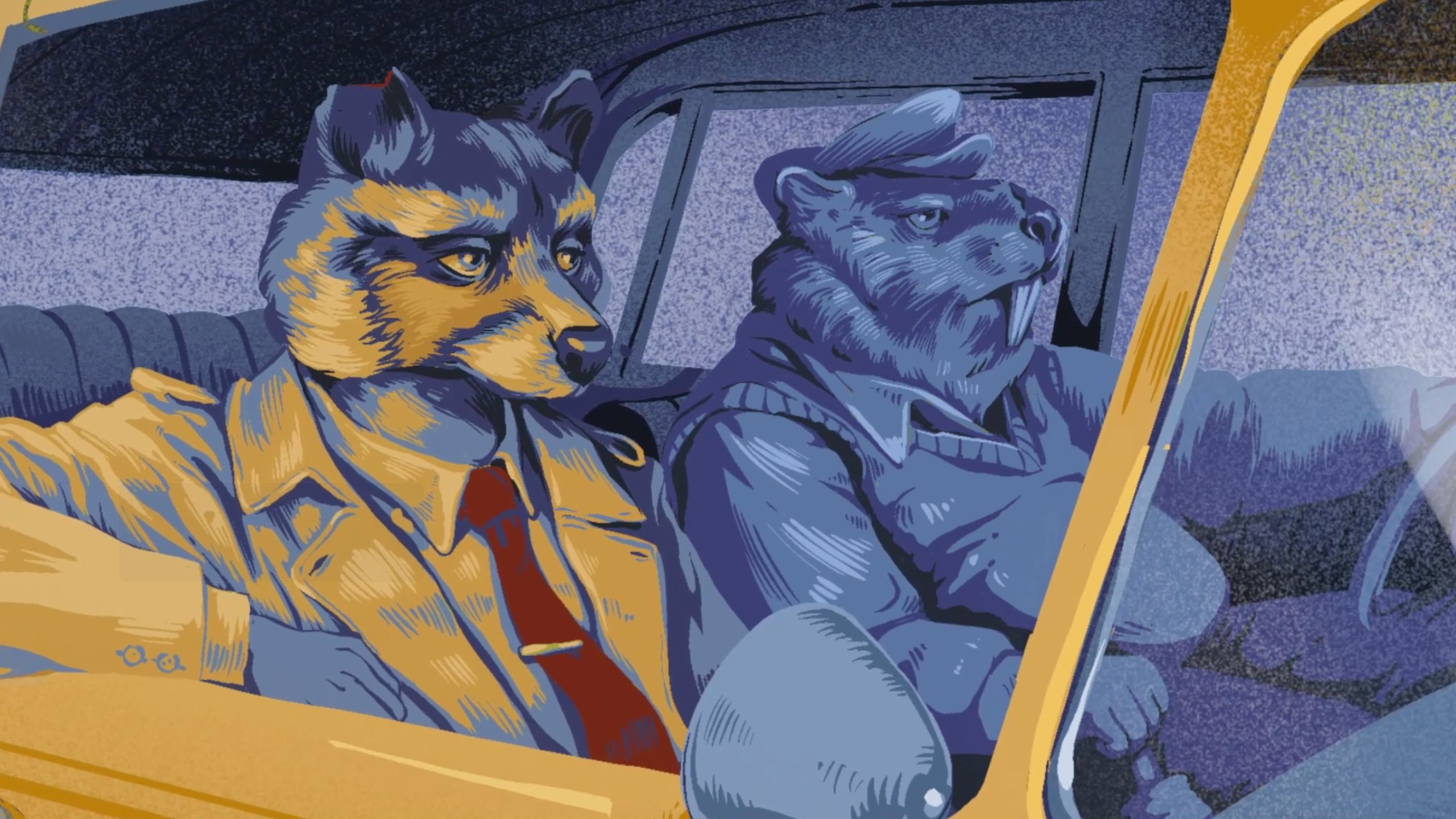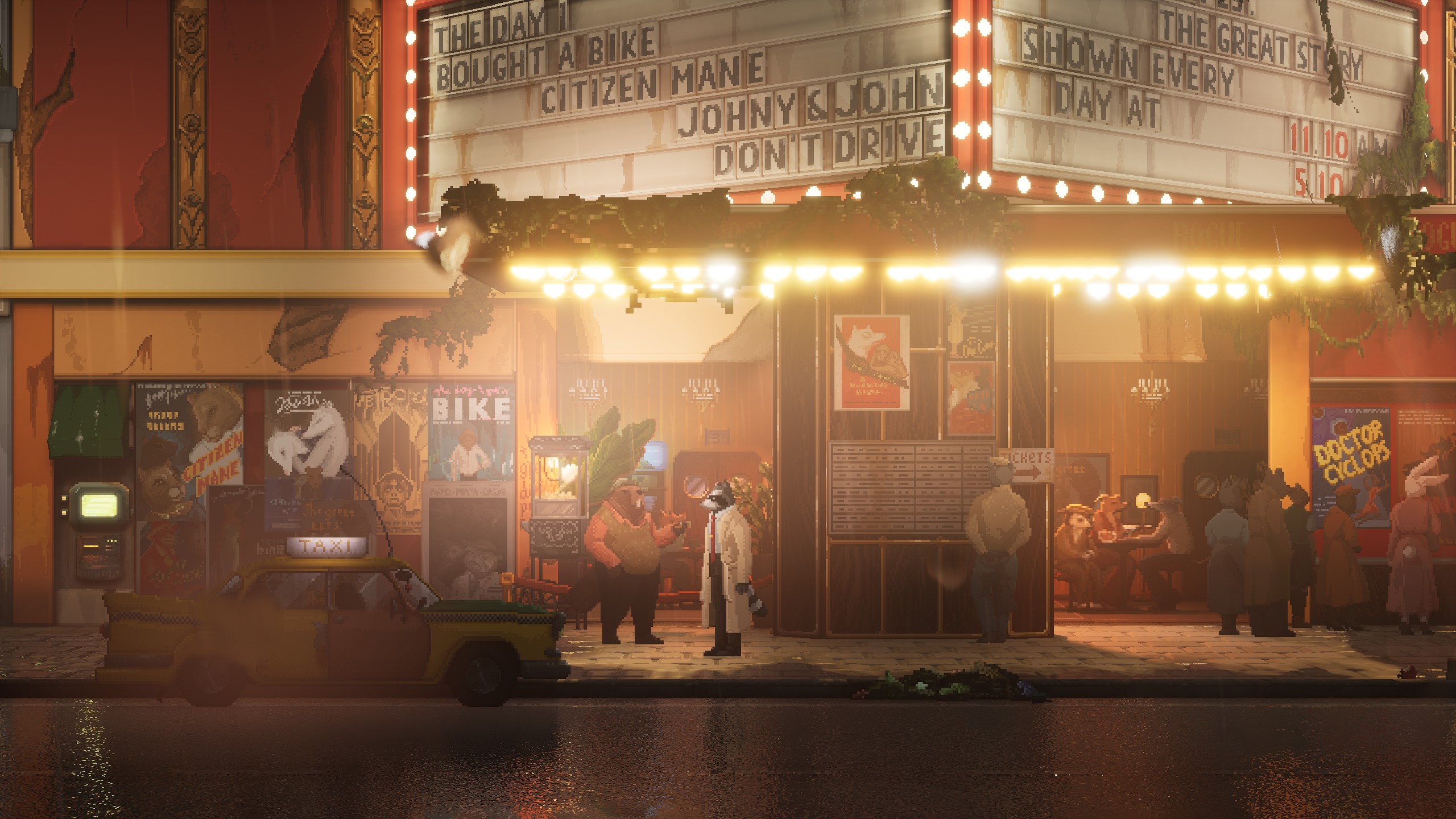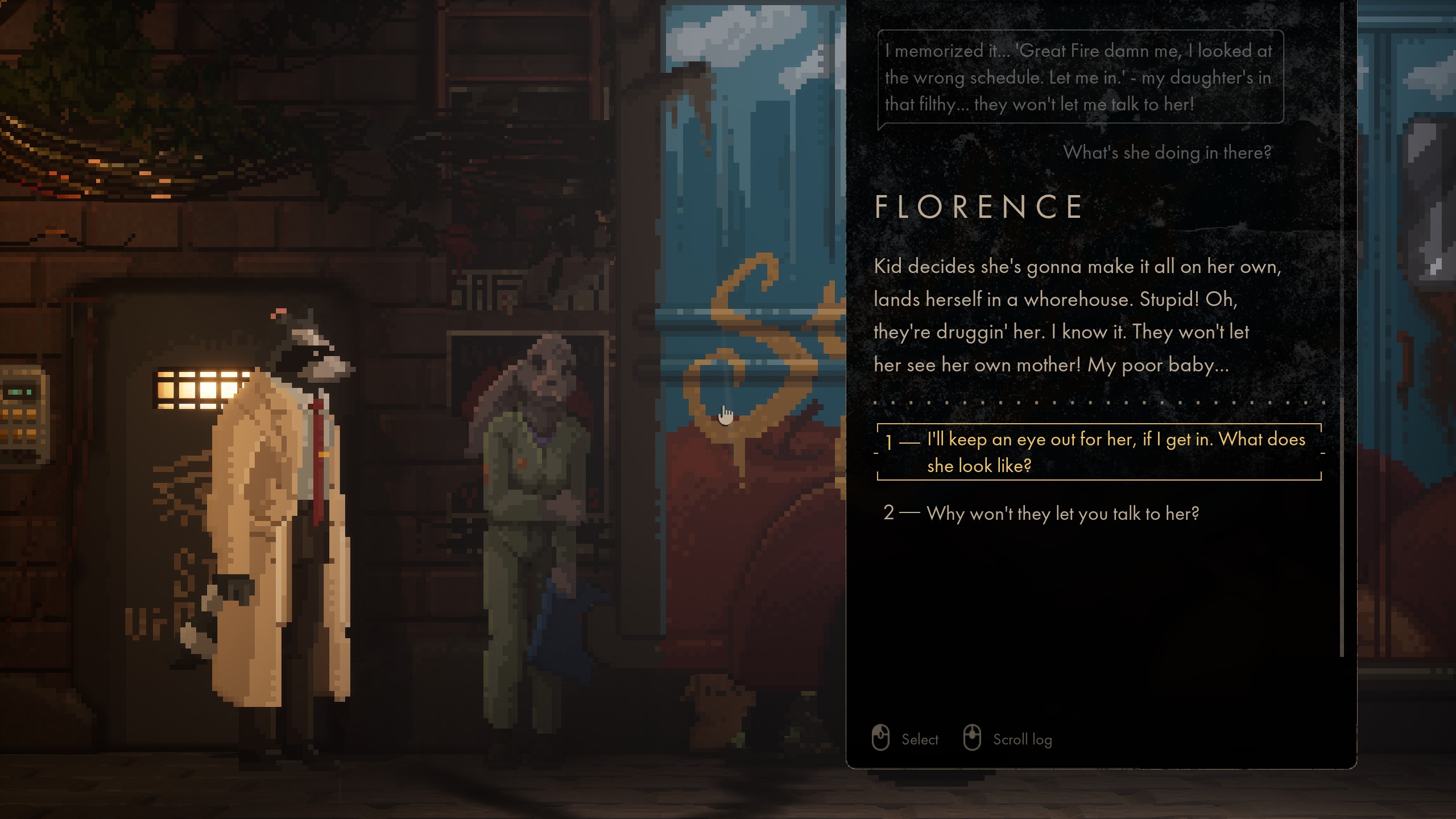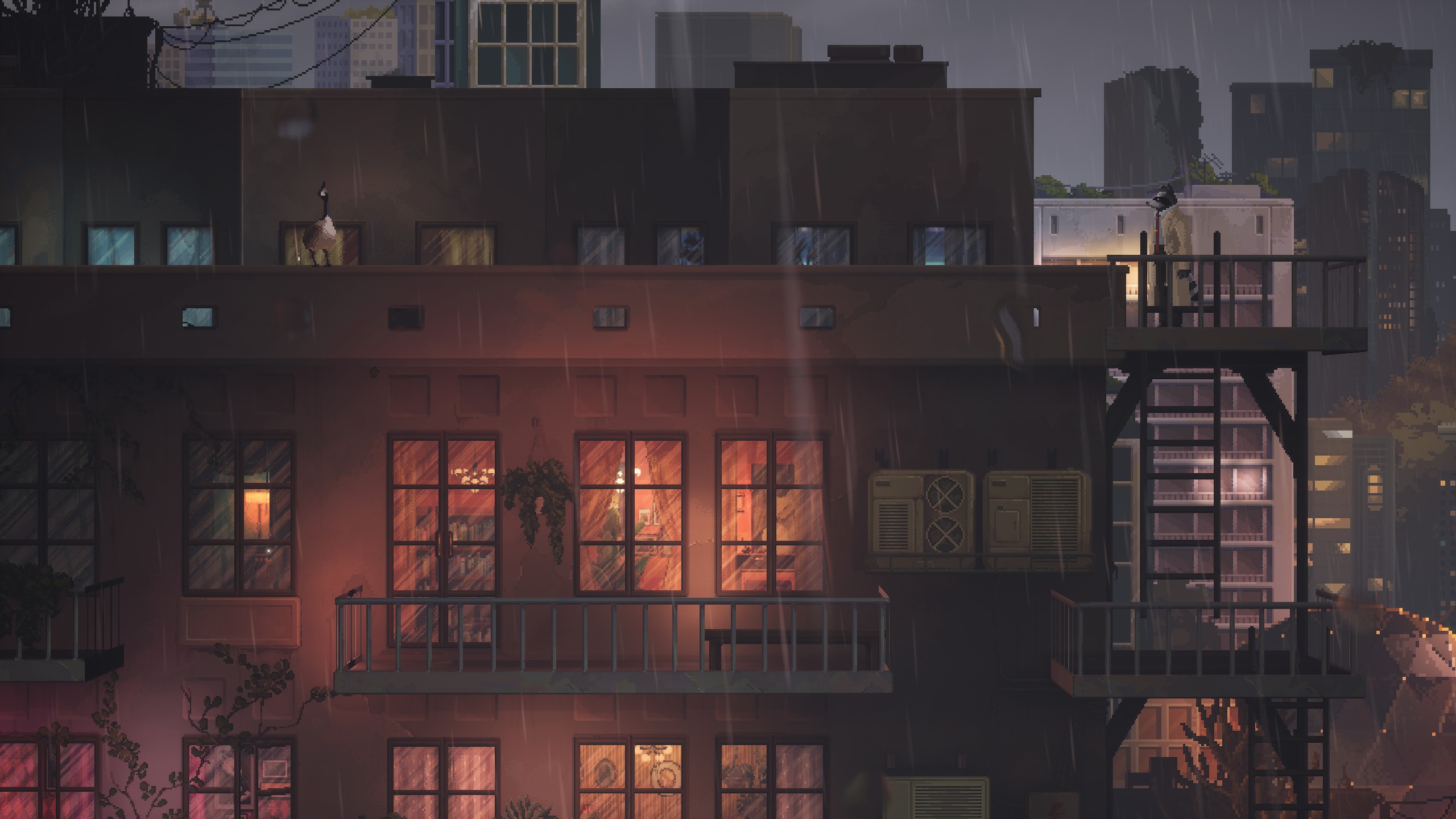Raccoon detective adventure Backbone is giving me the noir fix I need
Solve a spiraling mystery in a shady city in this gorgeous sidescroller.

Noir detective adventure Backbone comes along at just the right time for me. I've been on a detective film jag this past week, watching Philip Marlowe movies like The Big Sleep and The Long Goodbye, black comedy Kiss Kiss Bang Bang, and 1975 neo-noir thriller Night Moves. I'm fully in hard-boiled private investigator mode.
And now I'm a hard-boiled PI who is also a raccoon.
The side-scrolling world of Backbone is full of anthropomorphic animals. Gorillas, lions, and tigers form the rich and powerful upper echelons of society, while squirrels, beavers, rodents, and other furry critters represent the working class, pushing brooms, driving cabs, and selling newspapers and nuts on the street. My raccoon is a trenchcoat-clad private detective working what sounds like a relatively simple case: A worried otter suspects her missing husband (also an otter) is having an affair and asks me to track him down. Time to start snooping around.
When it comes to noir detective tales (or tails, in this case) the PI almost always gets in over their head, and Backbone is no exception. I'm not even all that far into Backbone yet, but things have already spiralled well beyond a missing otter case. What began with a husband who was suspected of sleeping with a woodchuck or a rabbit has turned far more disturbing and deadly.

As furry detective Howard I wander sections of the moody, rain-slick city looking for clues. If I walk past something—a citizen, a location, or object of interest—an icon appears above my head letting me know I can interact with it, doing away with a lot of the fruitless pixel hunting you sometimes see in adventure games. Sometimes Howard simply talks to himself, too, which simulates the noir trope of having the detective narrate his own story.
After carefully questioning some of the locals (trying not to broadcast that I'm a PI), I learn the missing otter frequents a nightclub. An intimidating bouncer is in my way, but I manage to find at least two options for dealing with him, and a bit later I find what looks like two different ways to sneak into a location I need to access. Puzzles with more than one solution are always welcome in adventure games.
With the option of speaking to a number of club-goers I unfortunately pick the actual owner of the club, who quickly sees through my ruse, and I'm chucked back on the street without much to show for it. The conversation system in Backbone is reminiscent of Disco Elysium's, where the chat scrolls up on the right side of the screen while you pick from various dialogue options, and it works pretty well here (and I never wind up arguing with my necktie). There's no voice acting in Backbone, only text, though that works for me, too. I personally would much rather read than listen in most games.
The biggest gaming news, reviews and hardware deals
Keep up to date with the most important stories and the best deals, as picked by the PC Gamer team.
Backbone throws in a few other systems besides walking and talking, though with a light touch. After I'm kicked out of the club I manage to find another way back inside, and there's a tiny bit of stealth involved, where I need to evade a security guard (a rat) by crouching and hiding behind furniture. Later I need to similarly sneak through a kitchen staffed by tigers. Getting caught doesn't hurt—I can try it again immediately, and the stealth sections are quick, not elaborate. I feel like they're mainly there to add to the mood rather than pose a real challenge.
There are traditional adventure game puzzles, too, but like the stealth they only pop up every now and then, which I appreciate. I don't play many adventure games these days. I got tired of collecting an inventory full of items that then need to be tried on other items, one by one. At least so far, most of what I need can be accomplished through conversations, and I think the fewer puzzles a game has, the more satisfying it is to solve them.

As far as choices go, you make a number of them during dialogue, though I can't yet tell how many truly matter. I was intent on not giving any information to a mysterious fox (literally, a fox) who showed up at a suspiciously beneficial moment. I know how often detectives get double-crossed, so I don't trust this fox and do my best not to tell her anything about myself or the case I'm working. But as our chats go on, I run out of ways to hide things from her. I'm going to be pretty annoyed if she turns out to be more of a rat than a fox.
I also enjoy the examination of evidence. After stealing a folder from someone's penthouse, the fox and I go through its contents and I'm asked to interpret the text of each note inside. Whereas a lot of games ask you to read a note, it really just registers that you've opened it and then simply updates your quest. Backbone asks you to come to conclusions about what you've read and what you think certains lines of text really mean. It helps you slowly process bits of the story, rather than simply hoping you've actually looked at the clues you've found.

I haven't cracked the case quite yet, but I'm looking forward to playing more of Backbone. The mystery, so far, is pretty intriguing, the dialogue is well-written, and the environments are beautiful and strike just the right moody tones for anyone looking to add a bit of noir to their lives.

Chris started playing PC games in the 1980s, started writing about them in the early 2000s, and (finally) started getting paid to write about them in the late 2000s. Following a few years as a regular freelancer, PC Gamer hired him in 2014, probably so he'd stop emailing them asking for more work. Chris has a love-hate relationship with survival games and an unhealthy fascination with the inner lives of NPCs. He's also a fan of offbeat simulation games, mods, and ignoring storylines in RPGs so he can make up his own.

